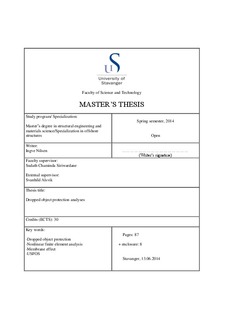| dc.contributor.author | Nilsen, Ingve | |
| dc.date.accessioned | 2014-09-17T06:50:25Z | |
| dc.date.available | 2014-09-17T06:50:25Z | |
| dc.date.issued | 2014-06-13 | |
| dc.identifier.uri | http://hdl.handle.net/11250/220019 | |
| dc.description | Master's thesis in Offshore structural engineering | nb_NO |
| dc.description.abstract | Impact from dropped object is a typical accident action (NOKSOK N-004, 2013). Hence, the DOP structure is to be analyzed in an accidental limit state (ALS) design practice, which means that a non-linear finite element analysis can be applied. The DOP structure will be based on a typical DOP structure.
Several FEM analyses are performed for the DOP structure. Different shapes size and weights and various impact positions are used for simulate the dropped object. By changing how the load from a dropped object is applied to the structure the result can be change. When the impact loads is applied to only one point of impact in the FE model. The plastic strain is much larger compared to the impact load is distributed between several points of impact.
In the analyses there will impact load in the middle of the plate, in the middle of the structure and the beam at the edge and in the end of the beam. Impact load in one node is compared to impact load in several nodes in the middle of the plate and in the beams. A DOP structure with additional beam is also model for reducing the strain and deflection. The DOP structure with additional beams is analyzed with impact in one node in the middle of the beams at the edge and the beam in the middle of the DOP structure. The DOP structure is also compared to a DOP structure without plates with respect to strain and deflection. There is also one analysis where the DOP structure is designed with aluminium for comparing with steel. Aluminium is about 1/3 of the weight of the steel.
The analyses are done by the nonlinear finite element program named USFOS, which also have dynamic capabilities. The DOP structure is first modelled in the structural analysis and design program Sesam GeniE. There are designed one original model, one model with modification for reducing the strain and deflection and one model without plates. The impact loads is designed as node mass with velocity for simulated the dropped object.
In analysis with a mass of 7000kg falling 3 meters acting in one node the maximum strain is 18.2%. 18.2% is achieved when the impact is in the middle of the beam at the edge of the DOP structure. The maximum strain is reduced to 12.5% when the mass is distributed evenly in three nodes. A DOP structure with added beams with the impact load in one node in the idle of the beam at the edge has maximum strain of 9.9%. With the extra beams in the DOP structure the beam span will be reduced, therefore lower strain and deflection.
The maximum expected strain in the middle of the plate is 17.9% with a mass of 7000kg falling 3 meters. If the mass is distributed over several nodes the maximum strain is reduced to 8.7% in the middle of the plate. For reducing the maximum strain in the plate the thickness can be increased.
A mass of 2000kg falling on the DOP structure will create 6.1% and 4.4cm deflection in the middle of the middle beam. If the plates on top of the DOP structure are removed the strain is increased to 8.1% and deflection to 9.1cm. The plates on top of the DOP structure obtain much of the energy with a membrane effect which results in reducing the strain and deflection. The DOP structure in aluminum with the same loading has maximum strain of 12.3% and deflection of 7.6cm. | nb_NO |
| dc.language.iso | eng | nb_NO |
| dc.publisher | University of Stavanger, Norway | nb_NO |
| dc.relation.ispartofseries | Masteroppgave/UIS-TN-IKM/2014; | |
| dc.rights | Attribution 3.0 Norway | * |
| dc.rights.uri | http://creativecommons.org/licenses/by/3.0/no/ | * |
| dc.subject | USFOS | nb_NO |
| dc.subject | offshore teknologi | nb_NO |
| dc.subject | konstruksjonsteknikk | nb_NO |
| dc.subject | dropped object protection | nb_NO |
| dc.subject | nonlinear finite element analysis | nb_NO |
| dc.subject | membrane effect | nb_NO |
| dc.subject | materialteknologi | nb_NO |
| dc.subject | byggkonstruksjoner | |
| dc.title | Dropped object protection analyses | nb_NO |
| dc.type | Master thesis | nb_NO |
| dc.subject.nsi | VDP::Technology: 500::Marine technology: 580::Offshore technology: 581 | nb_NO |

